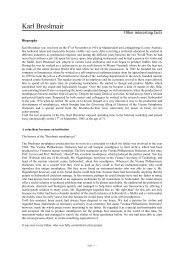Flugelhorn mouthpieces - Breslmair
Flugelhorn mouthpieces - Breslmair
Flugelhorn mouthpieces - Breslmair
Create successful ePaper yourself
Turn your PDF publications into a flip-book with our unique Google optimized e-Paper software.
Karl <strong>Breslmair</strong><br />
<strong>Flugelhorn</strong> <strong>mouthpieces</strong><br />
Seite - 1 -<br />
Flügelhorn <strong>mouthpieces</strong><br />
The tradition of brass music in rural areas would be unthinkable without the <strong>Flugelhorn</strong>, which apart from others<br />
forms the basis for the typical sound of our traditional Austrian music.<br />
This legato instrument harmonises very well with vocals, which should however not be spoiled by a trumpet-like<br />
sound picture caused by the <strong>Flugelhorn</strong>. It should submit to the singer's voice and emphasise it. The trumpet-like<br />
sound should be audible in bright colours and the typical sound of the <strong>Flugelhorn</strong> should stand out in softness<br />
and with a wide range of tones. In most cases however, trumpet <strong>mouthpieces</strong> are used for <strong>Flugelhorn</strong>s, which<br />
neither fit measurements nor meet the sound expectations of the instrument.<br />
Basically referring to the mouthpiece, a distinction between the German <strong>Flugelhorn</strong> with its rotary valves and the<br />
<strong>Flugelhorn</strong> with its piston system should be made. In contrast to the piston trumpet, the bore of the mouthpiece<br />
should be wider than the one for a rotary system. Piston-<strong>Flugelhorn</strong>s are mainly used for Jazz and modern music<br />
and the desired sound picture is mostly dark, smoky, i.e. groovy.<br />
Apart from all individuality my recommendation would be to choose a 3.8mm bore for a <strong>Flugelhorn</strong> with rotary<br />
valves. A bore of more than 4.0mm creates a tone that is too rough and not enough accentuated and a bore of less<br />
than 3.6mm is not very recommendable, as the tone would be too shrill and sharp. These recommendations are<br />
applicable, if the cup of a mouthpiece is deeper than the one of a very deep trumpet mouthpiece, and if the cup is<br />
very V-shaped.<br />
Because of its design the <strong>Flugelhorn</strong> mouthpiece has a wider back bore than the trumpet mouthpiece.<br />
The German <strong>Flugelhorn</strong> has a mouth pipe width of 11.3mm, whereas the French, the American and the<br />
YAMAHA <strong>Flugelhorn</strong> have mouth pipe widths of 10.3mm. Sometimes the Czech instruments have the same<br />
small mouth pipe width of 10.3mm (Amati), despite their rotary valves.<br />
Consequently we assist the customer in realising his/her sound expectation by finding the best fitting bore to the<br />
respective shank, or by providing an individualised bore, according to the customer's request.<br />
At present our assortment comprises ten <strong>Flugelhorn</strong> <strong>mouthpieces</strong>.<br />
Preview of models – <strong>Flugelhorn</strong> <strong>mouthpieces</strong><br />
designation model depth bore Ø<br />
F9 G3F S 3,80<br />
F8 G2F M 3,80<br />
F7 FN T 3,80<br />
F6 G1F T 3,80<br />
F5 G13F MT 3,90<br />
F4 G12F T 3,80<br />
F3 G11F MT 3,80<br />
F2 38 MT 3,80<br />
F1 42 TT 4,20<br />
F0 43 TT 4,30<br />
Complete <strong>Flugelhorn</strong> <strong>mouthpieces</strong> F6, F8 and F9 are produced as a complete model with rim contour "G" as<br />
well as a module model (two parts).<br />
Normally two-piece versions of all our models are produced. The advantage of such a model is that all the<br />
various rims of the trumpet module system can be used.
Karl <strong>Breslmair</strong><br />
Comparison of the shapes of different <strong>Flugelhorn</strong> cups<br />
Figure 6: <strong>Flugelhorn</strong> cups<br />
Seite - 2 -<br />
Flügelhorn <strong>mouthpieces</strong>





